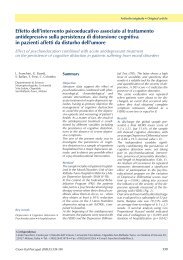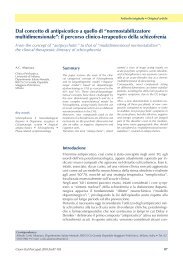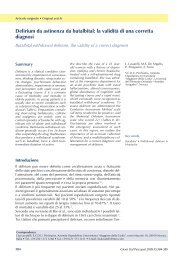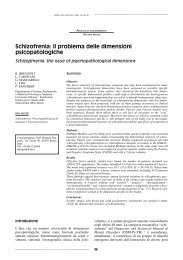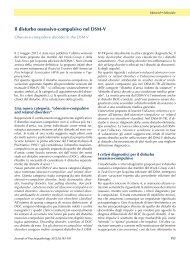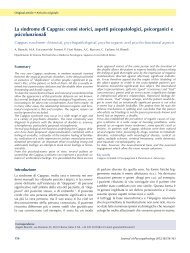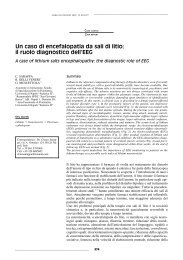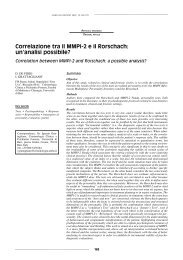XI Congresso della Società Italiana di Psicopatologia Psichiatria ...
XI Congresso della Società Italiana di Psicopatologia Psichiatria ...
XI Congresso della Società Italiana di Psicopatologia Psichiatria ...
Create successful ePaper yourself
Turn your PDF publications into a flip-book with our unique Google optimized e-Paper software.
Fig. 2.<br />
Pre<strong>di</strong>cting schizophrenia with structural<br />
MRI<br />
S.M. Lawrie<br />
University of E<strong>di</strong>nburgh, Scotland<br />
Introduction: numerous MRI stu<strong>di</strong>es of the brain in schizophrenia<br />
have repeatedly demonstrated structural abnormalities,<br />
particularly of the temporal lobes. Stu<strong>di</strong>es of people at<br />
high risk suggest that some of these changes occur before<br />
the onset of the <strong>di</strong>sorder, and might therefore be used in pre<strong>di</strong>ction.<br />
Methodology: we conducted sMRI scans in 150 high risk<br />
subjects aged 16-25 at baseline and 66 of them after approximately<br />
2 years. Healthy age-matched controls have also<br />
been scanned.<br />
Comparisons were made between those who developed<br />
schizophrenia, well controls, a well high risk group and<br />
those of the high risk sample with partial or isolated psychotic<br />
symptoms.<br />
Results: we have found associations between pre-frontal<br />
and basal ganglia volumes with genetic liability, and reductions<br />
in me<strong>di</strong>al temporal lobe and thalamus volumes in the<br />
high risk group compared to controls, at baseline. Me<strong>di</strong>al<br />
and lateral (fusiform) temporal lobe volumes <strong>di</strong>d not pre<strong>di</strong>ct<br />
psychosis but reduced further in association with psychotic<br />
symptoms and in those who went on to develop psychosis.<br />
These measures had impressive positive pre<strong>di</strong>ctive power of<br />
80%.<br />
Conclusions: overall, the results suggest that some abnormalities<br />
of the brain in high risk subjects are genetically me<strong>di</strong>ated<br />
and developmental, that others may only become apparent<br />
in late adolescence for unclear reasons, and that psychotic<br />
symptoms and psychosis are associated with further<br />
structural changes. sMRI could have a role in the early <strong>di</strong>agnosis<br />
of schizophrenia.<br />
177<br />
SIMPOSI TEMATICI<br />
Nuovi obiettivi <strong>della</strong> Risonanza Magnetica<br />
nello stu<strong>di</strong>o delle funzioni del cervello<br />
umano<br />
B. Maraviglia<br />
Dipartimento <strong>di</strong> Fisica, Università <strong>di</strong> Roma “La Sapienza”<br />
La conoscenza dell’architettura e <strong>della</strong> funzione del Cervello<br />
Umano è un obiettivo cruciale sia per comprendere la nostra<br />
identità sia per imparare ad intervenire appropriatamente<br />
nelle forme patologiche e degenerative che lo affliggono.<br />
La grande complessità del Sistema Nervoso Centrale (SNC)<br />
rende necessaria la convergenza <strong>di</strong> ogni possibile metodo <strong>di</strong><br />
indagine e quin<strong>di</strong> una stretta collaborazione fra me<strong>di</strong>ci, fisici,<br />
biologi, ingegneri, ecc., in modo da orientare la ricerca<br />
verso obiettivi quantificabili attraverso l’uso <strong>di</strong> rigorose<br />
procedure sperimentali, secondo il metodo Galileiano.<br />
Da poco più <strong>di</strong> <strong>di</strong>eci anni, l’invenzione dell’Imaging funzionale<br />
con Risonanza Magnetica (fMRI) costituisce un<br />
nuovo metodo per stu<strong>di</strong>are la funzione cerebrale con numerosi<br />
vantaggi rispetto ad altri meto<strong>di</strong> <strong>di</strong> imaging. Infatti la<br />
fMRI ha consentito l’indagine dei processi cognitivi e senso-motori<br />
con risoluzioni nominali spaziale e temporale pari,<br />
rispettivamente, a pochi millimetri e a centinaia <strong>di</strong> millisecon<strong>di</strong>,<br />
facendo uso <strong>di</strong> ra<strong>di</strong>azioni non ionizzanti e con la<br />
possibilità <strong>di</strong> ripetere le misure sullo stesso soggetto. Il metodo<br />
BOLD (Blood Oxygenation Level Dependent) è il più<br />
<strong>di</strong>ffuso fra le varie strategie fMRI, grazie alla sua <strong>di</strong>sponibilità<br />
sui tomografi clinici e alla sua capacità <strong>di</strong> acquisire strati<br />
dell’intero cervello in pochi secon<strong>di</strong>. Nonostante ciò, le<br />
effettive risoluzioni <strong>della</strong> BOLD fMRI sono limitate dal<br />
contrasto BOLD stesso, che deriva da effetti secondari piuttosto<br />
che dagli effetti <strong>di</strong>retti dell’attivazione neuronale. La<br />
riduzione delle risoluzioni spaziale e temporale sono causate<br />
dalla stretta connessione dell’effetto BOLD con la risposta<br />
emo<strong>di</strong>namica. Questo fatto introduce anche non poche<br />
incertezze sulle vali<strong>di</strong>tà delle aree attivate a causa <strong>di</strong> possibili<br />
effetti puramente emo<strong>di</strong>namici non connessi alla attivazione<br />
neuronale. In base a queste considerazioni è chiaro<br />
che si rende necessaria la ricerca <strong>di</strong> altri meto<strong>di</strong> che possano<br />
rendere le misure <strong>di</strong> localizzazione più atten<strong>di</strong>bili, più<br />
definite ed inoltre meglio risolte temporalmente in modo da<br />
poter approfon<strong>di</strong>re la <strong>di</strong>namica <strong>di</strong> attivazione delle varie<br />
aree con la sequenzialità che ne faccia capire il ruolo e la gerarchia.<br />
Il mio gruppo <strong>di</strong> ricerca, con il sostegno del Centro “E. Fermi”<br />
<strong>di</strong> Roma, sta sviluppando, soprattutto presso i Laboratori<br />
del “S. Lucia” <strong>di</strong> Roma, una serie <strong>di</strong> linee <strong>di</strong> ricerca che<br />
sono qui schematizzate:<br />
1)realizzazione <strong>di</strong> nuove procedure per la misura contemporanea<br />
<strong>di</strong> fMRI e EEG in modo da utilizzare l’alta risoluzione<br />
temporale dell’EEG assieme alla risoluzione spaziale<br />
<strong>della</strong> fMRI e MRI. Da questa base abbiamo avviato<br />
stu<strong>di</strong> su:<br />
– potenziali evocati generati dall’attivazione cerebrale,<br />
contemporaneamente alla determinazione con fMRI <strong>della</strong><br />
parte <strong>di</strong> corteccia coinvolta,<br />
– gli effetti deboli sul campo magnetico causati dalle neurocorrenti<br />
con possibilità <strong>di</strong> localizzare <strong>di</strong>rettamente il<br />
processo <strong>di</strong> attivazione corticale,<br />
– applicazioni alle epilessie, per le quali è possibile localizzare<br />
con fMRI le aree responsabili delle scariche. Queste




